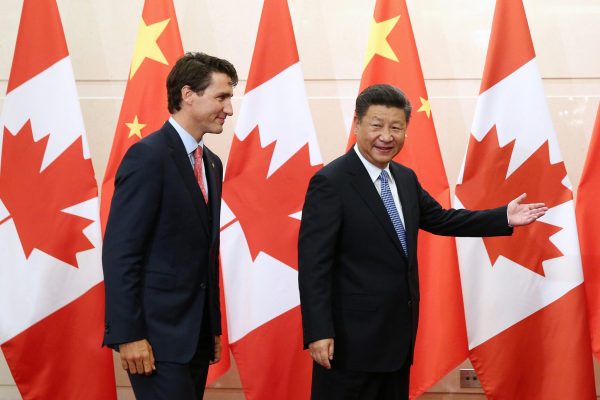Given this massive and unprecedented shift in the global centre of gravity from the United States to China, how should Canada react to the BRI and approach its relationship with China?
Freedom of information, privacy and the protection of individual and intellectual rights are foundational values in Canadian society. These values can sometimes come into conflict with the Chinese regime, the political priorities of which are linked to the continuity of leadership and domestic stability. In April 2018, China rejected a free trade deal with Canada due to the deal’s ‘progressive’ elements, which were pushed by the Trudeau government and seen as interferences in China’s internal affairs.
Though the shared values between Canada and the United States may be stronger at present, a 2017 Pew Research Center survey suggests that China’s soft power is increasing and challenging that of the United States.
Four per cent of the Canadian population is also either ethnic Chinese or mixed, consisting of about 1.56 million people or about 40 per cent of all Asian-Canadians in 2016. Chinese-Canadians make a significant contribution to Canadian society in entrepreneurship, science and technology. They are generally higher educated and higher paid than the average population, and well-placed to help bridge the two countries’ cultural, administrative and economic differences through private sector engagement in bilateral trade and investment.
Canada is a recipient of both direct and portfolio investments from China. In 2017, Chinese foreign direct investment in Canada reached US$270 billion, more than double the amount in 2011. This significant rise is a result of mergers and acquisitions by Chinese firms, particularly state-owned ones. The majority of this investment is in three sectors: energy, consumer products and services, and housing and entertainment.
Portfolio financial flows are also significant, but some are linked to corrupt officials or capital flight. The Chinese and Canadian governments are cooperating on international corruption charges levied against some Chinese citizens and ex-politicians.
The General Administration of Customs reported that bilateral trade between the two countries exceeded US$42 billion in 2017, with over US$25 billion in exports from Canada to China. While China is more important to Canada than Canada is to China, Canada has a comparative advantage in land, natural resources and highly skilled labour. Canada’s trade with China is still in its infancy. While the United States was the destination of 76.4 per cent of Canada’s exports in 2017, China constituted only 4.3 per cent.
The BRI will change China’s supply chain management by lowering transportation costs to China for multiple classes of products, affecting small and medium enterprises and multi-national corporations alike. What are the implications of the BRI for Canada? For starters, Canada is not really part of BRI, at least not its direct roads and belts — with the potential exception of the Arctic. China plans to build a ‘Polar Silk Road’, but for the time being its role in the Arctic is still modest, research-based and focussed on maritime navigation.
While Canada is not officially part of the BRI, it became a member of the Asian Infrastructure Investment Bank in 2017, signalling its financial interest in BRI projects. Canada has the potential to make significant contributions to the BRI. Canadian companies are experienced in building infrastructure, especially in harsh environments, and Canadian workers are world class. China can source BRI-related products and expertise from Canada, and Canada can benefit from the scale that China and its trading partners can bring.
Canada should respect Chinese sovereignty and autonomy on domestic issues if it wants to avoid retaliation and negative economic consequences. On business matters — such as the intellectual property rights of Canadian firms, the treatment of Canadian firms in China and unfair competition —the Canadian government can afford to take a stronger stance and push for more reform and opening. Canada is less threatening to China than the United States, but can coalesce with the United States and the European Union to affect positive change in such areas.
Canada and China should also try to develop a more transparent exchange system for financial flows. Canada generally benefits from Chinese financial flows. Canada is a safe haven for Chinese portfolio investment and a source of both knowledge and resources for direct investors. Canadian companies are acquisition targets for Chinese investors and have much to contribute to China’s economy and society. But caution over dual-use, sensitive technology firms is warranted.
For a relatively small population, Canada is well entrenched in China’s flows of people, money and products. As the United States becomes increasingly hostile to China, Canada can pick up the slack and fill the engagement void. Canada has made it clear that, despite a clause on trade with ‘non-market economies’ in the US–Mexico–Canada trade agreement, Canada is looking to expand business with China.
Ilan Alon is Professor of Strategy and International Marketing at the School of Business and Law at the University of Agder, Norway.
Shan Chen is Assistant Professor in the Department of Management, Economics and Industrial Engineering at the Polytechnic University of Milan, Italy.

